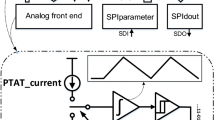Abstract
Electrical analog modeling is the conventional way for the discussion of how thermoanalytical devices work. This tradition goes back to the 50–60s of the twentieth century, when the electric circuits worked with analog signal, and RC circuits were the advanced tool for the calculation of integrals and derivatives. Today the electric circuits work with digital signal, and the computation is performed with microchips and computers. Electrical analog modeling failed to explain how DSC calibration coefficient changes with temperature. This problem was solved by means of direct thermophysical consideration. The temperature of maximum sensitivity for three DSCs is shown to obey the equation for the calibration coefficient.





Similar content being viewed by others
References
Rodríguez de Rivera M, Socorro F, Matos JS. Modeling of the thermal effects involved in the determination of heat of mixing, using an ITC operating in continuous mode. J Therm Anal Calorim. 2010;99:791–7.
Khane V, Usman S. Further on integrator circuit analogy for natural convection. Nucl Eng Des. 2010;240:609–15.
Couto SM. Modeling grain drying as discharge of an RC electrical circuit. Trans ASAE. 2002;45:1445–54.
Mudd C. Evaluation of phase transition errors in heat capacity calorimeters using SPICE simulated RC models. J Biochem Biophys Meth. 1999;39:7–38.
Nam S-K, Kim J-K, Cho S-C, Lee S-K. Design and characterization of a high resolution microfluidic heat flux sensor with thermal modulation. Sensors. 2010;10:6594–611.
Swietoslawski W. Microcalorimetry. New York: Reinhold Pub. Corp.; 1946.
Calvet E, Prat H. Microcalorimétrie: Applications Physico-chimiques et Bioloques. Paris: Masson ETCie; 1956.
Hemminger W, Höhne G. Calorimetry. Fundamentals and practice. Weinheim: Verlag Chemie GmbH; 1984.
Šestác J. Thermophysical properties of solids: their measurements and theoretical thermal analysis. Prague: Academia; 1984.
Zielenkiewicz W. Calorimetry. Warszawa: Institute of Physical Chemistry of the Polish Academy of Sciences; 2005.
Wendlandt WW. Thermal methods of analysis. New York: Wiley-Interscience; 1974. p. 505.
Dosch EL. An electrical technique for characterization of response parameters of DTA sample holders. Thermochim Acta. 1970;1:367–71.
Bush V. Structural analysis by electric circuit analogies. J Franklin Inst. 1934;217:289–329.
Gutenmakher LI. Electrical models. Moscow: USSR Academy of Sciences; 1949. (in Russian).
Liebman G. A new electrical analog method for the solution of transient heat conduction problems. Trans ASME. 1956;78:655–65.
Tetelbaum IM. Elektrische Analogierechenverfahren. Berlin: Verlag Technik; 1963.
Gusenkov GN, Krestov GA. Problems of non-linear theory in differential scanning calorimetry. J Therm Anal. 1978;13:369–86.
Seybold K, Meisel T, Cserfalvi T. Modeling of quantitative DTA equipment I. Electric analog approach. J Therm Anal. 1979;15:93–100.
Sarge SM, Gmelin E, Höhne GWH, Cammenga HK, Hemminger W, Eysel W. The caloric calibration of scanning calorimeters. Thermochim Acta. 1994;247:129–68.
Sarge SM, Höhne GWH, Cammenga HK, Eysel W, Gmelin E. Temperature, heat and heat flow calibration of scanning calorimeters in the cooling mode. Thermochim Acta. 2000;361:1–20.
Drebushchak VA. Calibration coefficient of a heat-flow DSC—part 1. Relation to the sensitivity of a thermocouple. J Therm Anal Calorim. 2004;76:941–7.
Drebushchak VA. Calibration coefficient of a heat-flow DSC—part 2. Optimal calibration procedure. J Therm Anal Calorim. 2005;79:213–8.
Drebushchak VA. Approximation of the emf of a thermocouple. Part 1. The polynomials of temperature and Runge’s phenomenon. J Therm Anal Calorim. 2009;96:315–20.
Marti E, Kaisersberger E, Emmerich W-D. New aspects of thermal analysis. Part I. Resolution of DSC and means for its optimization. J Therm Anal Calorim. 2004;77:905–34.
Aubuchon SR. Recent developments in DSC technology. In: ESTAC-10. Abstract Book; 2010. p. 49.
van Ekeren PJ, Hakvoort G, de Klerk WPC, Van den Mooter GRJ, Vanden Poel G, Pijpers MFJ, Witteveen AJ. Renewal of the TAWN test for measuring the resolution of DSCs. In: ESTAC—10 Program, Rotterdam; 2010.
Drebushchak VA. Calibration coefficient of a heat-flow DSC—part 3. Electromotive force of a thermocouple as a function of temperature. J Therm Anal Calorim. 2007;90:289–98.
Author information
Authors and Affiliations
Corresponding author
Rights and permissions
About this article
Cite this article
Drebushchak, V.A. From electrical analog to thermophysical modeling of DSC. J Therm Anal Calorim 105, 495–500 (2011). https://doi.org/10.1007/s10973-010-1200-3
Published:
Issue Date:
DOI: https://doi.org/10.1007/s10973-010-1200-3




